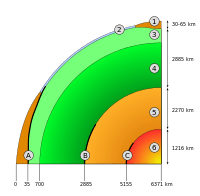Astrognosy/Laboratory
< AstrognosyThis laboratory is an activity for you to engage in astrognosy. While it may become a part of the astronomy course principles of radiation astronomy, it is also independent.
By combining a theory with experimental testing, you are to accomplish the mission of explaining an astronomical situation.
This learning activity is a series of puzzles about the constitution of known and unknown objects or sources, where you are free to make some guesses, evaluate them, and test your suppositions against observations.
Evaluation
|
Earth
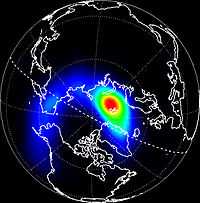
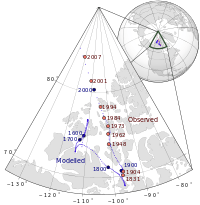
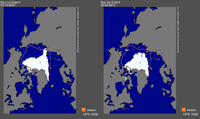
Def. “[t]he geological study of the Earth's structure and composition”[1] is called geognosy.
The Earth is a known astronomical object. It is usually not thought of as an X-ray source.
At right is a composite image which contains the first picture of the Earth in X-rays, taken in March, 1996, with the orbiting Polar satellite. The area of brightest X-ray emission is red. An appropriate projection of the Earth has been added.
While an interpretation can be found in X-ray astronomy, what if anything does this X-ray image tell you about the astrognosy, or geognosy, of Earth?
Try calculating a correlation factor for the location of highest X-ray intensity with the most likely location of the Earth's geomagnetic north pole, indicated in the diagram on the left.
The second image on the left shows the approximate location of the geographic north pole of Earth per its rotation.
Calculate a correlation factor between the center of X-ray intensity and this pole. Which correlation factor is greatest?
Another source,[2] on the journal's abstract page, allows you access to several figures from the text. On those, where there is a center of X-ray intensity similar to the one shown here, estimate its latitude and longitude, and compare correlation factors between the two north poles of Earth.
The Earth is estimated to have a net charge on its solid and liquid surface of 300,000 coulombs. What is the magnetic strength of the geographic north pole?
Is the magnetic strength of the geographic north pole greater than that of the geomagnetic north pole?
Sampling
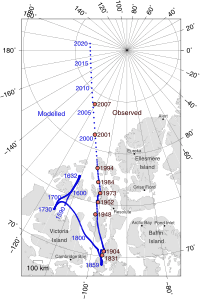

In the image on the right, the magnetic north pole of the Earth has been relocating itself. Its movement even appears to be accelerating.
On the left is a solid, spherical magnet suspended between two poles of another magnet generated by an electric current. The cable connected to an outlet is on the lower right edge.
From geoseismology the Earth is known not to be a solid spheroid. Some liquid exist between the crust and the inner core (an apparent solid). As silicate minerals can carry current, it is likely that the liquid portion is also electrically conducting.
To conduct an experiment I am assuming that the projection on the right has been made to allow correct distances to be measured. I will use a millimeter scale and the file image on the file page to measure distances between pole points paired with dates and approximate locations.
| Date | Latitude ° | Longitude ° | Distance (mm) | Years | △ in Direction ° | Accelerations |
|---|---|---|---|---|---|---|
| 1590 | 74 | -112 | 0 | 0 | 0 | 0 |
| 1600 | 76 | -112 | 9 | 10 | 0 | 0 |
| 1632 | 77 | -111 | 8 | 32 | 180, -45 | 2 |
| 1700 | 74.5 | -114 | 15 | 68 | +45 | 1 |
| 1730 | 73 | -115 | 8 | 30 | -180, +60 | 2 |
| 1800 | 72 | -102 | 21 | 70 | 30 | 1 |
| 1831 | 70 | -97 | 13 | 31 | -30 | 1 |
| 1859 | 69 | -97 | 14 | 28 | 180 | 1 |
| 1904 | 70.5 | -97 | 2 | 45 | +30 | 1 |
| 1948 | 74 | -100 | 20 | 44 | -3 | 1 |
| 1962 | 75 | -100 | 6 | 14 | -2 | 1 |
| 1973 | 76 | -100 | 4 | 11 | 10 | 1 |
| 1984 | 77 | -103 | 5 | 11 | 0 | 0 |
| 1994 | 78 | -105 | 6 | 10 | 0 | 0 |
| 2001 | 81 | -111 | 17 | 7 | 0 | 0 |
| 2007 | 84 | -120 | 16 | 6 | 0 | 0 |
Scale: 100 km : 5 mm.
Original research
- See also: Original research inquiry and Research
Hypothesis:
- The internal structure of each astronomical object should contain an electrically conducting medium of some kind.
I will provide an example of a control group for my astrognosy example. You will need to provide at least one also.
- See also: Control groups, Proof of concept, and Proof of technology
See also
References
- ↑ "geognosy, In: Wiktionary". San Francisco, California: Wikimedia Foundation, Inc. August 23, 2011. Retrieved 2012-06-06.
- ↑ W. L. Imhof, R. R. Anderson, S. M. Petrinec, D. W. Datiowe, J. Mobilia, H. Matsumoto, and K. Hashimoto (2007). "Observed X-rays associated with kilometric continuum". Journal of Geophysical Research 112: 17. doi:10.1029/2006JA012035. http://www.agu.org/pubs/crossref/2007/2006JA012035.shtml. Retrieved 2012-10-05.
External links
- African Journals Online
- Bing Advanced search
- Google Books
- Google scholar Advanced Scholar Search
- International Astronomical Union
- JSTOR
- Lycos search
- NASA/IPAC Extragalactic Database - NED
- NASA's National Space Science Data Center
- NCBI All Databases Search
- Office of Scientific & Technical Information
- PubChem Public Chemical Database
- Questia - The Online Library of Books and Journals
- SAGE journals online
- The SAO/NASA Astrophysics Data System
- Scirus for scientific information only advanced search
- SDSS Quick Look tool: SkyServer
- SIMBAD Astronomical Database
- SIMBAD Web interface, Harvard alternate
- Spacecraft Query at NASA.
- SpringerLink
- Taylor & Francis Online
- Universal coordinate converter
- Wiley Online Library Advanced Search
- Yahoo Advanced Web Search
| |||||||||||||||||||||||||||||||||||
| ||||||||||||||||||||||||||||||||
| |||||||||||||||||||||||||||||||||||
| |||||||||||||||||||||||||||||||||||||||||
| ||||||||||||||||||||||||||||||||||||||||||||
![]() This is a research project at http://en.wikiversity.org
This is a research project at http://en.wikiversity.org
| |
Subject classification: this is an astronomy resource. |
| |
Subject classification: this is an astrophysics resource. |
| |
Subject classification: this is a Geology resource. |
